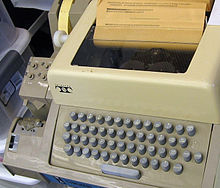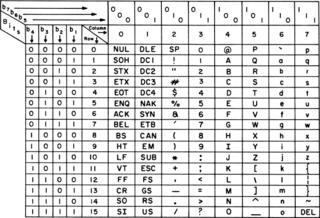
ASCII, an acronym for American Standard Code for Information Interchange, is a character encoding standard for electronic communication. ASCII codes represent text in computers, telecommunications equipment, and other devices. ASCII has just 128 code points, of which only 95 are printable characters, which severely limited its scope. The set of available punctuation had significant impact on the syntax of computer languages and text markup. ASCII hugely influenced the design of character sets used by modern computers, including Unicode which has over a million code points, but the first 128 of these are the same as ASCII.

The Baudot code is an early character encoding for telegraphy invented by Émile Baudot in the 1870s. It was the predecessor to the International Telegraph Alphabet No. 2 (ITA2), the most common teleprinter code in use before ASCII. Each character in the alphabet is represented by a series of five bits, sent over a communication channel such as a telegraph wire or a radio signal by asynchronous serial communication. The symbol rate measurement is known as baud, and is derived from the same name.
The keyboard for IBM PC-compatible computers is standardized. However, during the more than 30 years of PC architecture being frequently updated, many keyboard layout variations have been developed.

QWERTY is a keyboard layout for Latin-script alphabets. The name comes from the order of the first six keys on the top letter row of the keyboard: QWERTY. The QWERTY design is based on a layout included in the Sholes and Glidden typewriter sold via E. Remington and Sons from 1874. QWERTY became popular with the success of the Remington No. 2 of 1878 and remains in ubiquitous use.
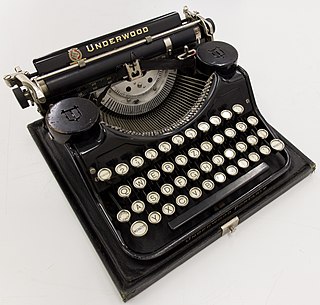
A typewriter is a mechanical or electromechanical machine for typing characters. Typically, a typewriter has an array of keys, and each one causes a different single character to be produced on paper by striking an inked ribbon selectively against the paper with a type element. Thereby, the machine produces a legible written document composed of ink and paper. By the end of the 19th century, a person who used such a device was also referred to as a typewriter.

The IBM Electric were an early series of electric typewriters that IBM manufactured, starting in the mid-1930s. They used the conventional moving carriage and typebar mechanism, as opposed to the fixed carriage and type ball used in the IBM Selectric, introduced in 1961. After 1944, each model came in both "Standard" and "Executive" versions, the latter featuring proportional spacing.

The QWERTZ or QWERTZU keyboard is a typewriter and keyboard layout widely used in Central and Southeast Europe. The name comes from the first six letters at the top left of the keyboard:.
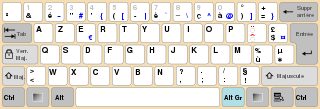
AZERTY is a specific layout for the characters of the Latin alphabet on typewriter keys and computer keyboards. The layout takes its name from the first six letters to appear on the first row of alphabetical keys; that is,. Similar to the QWERTZ layout, it is modelled on the English QWERTY layout. It is used in France and Belgium, although each of these countries has its own national variation on the layout. Luxembourg and Switzerland use the Swiss QWERTZ keyboard. Most residents of Quebec, the mainly French-speaking province of Canada, use a QWERTY keyboard that has been adapted to the French language such as the Multilingual Standard keyboard CAN/CSA Z243.200-92 which is stipulated by the government of Quebec and the Government of Canada.
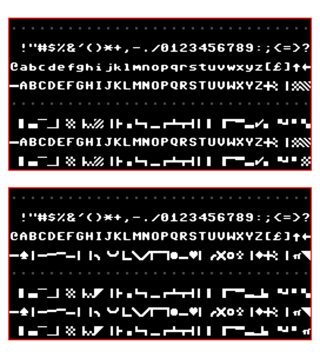
PETSCII, also known as CBM ASCII, is the character set used in Commodore Business Machines' 8-bit home computers.
The backtick` is a typographical mark used mainly in computing. It is also known as backquote, grave, or grave accent.
A telegraph code is one of the character encodings used to transmit information by telegraphy. Morse code is the best-known such code. Telegraphy usually refers to the electrical telegraph, but telegraph systems using the optical telegraph were in use before that. A code consists of a number of code points, each corresponding to a letter of the alphabet, a numeral, or some other character. In codes intended for machines rather than humans, code points for control characters, such as carriage return, are required to control the operation of the mechanism. Each code point is made up of a number of elements arranged in a unique way for that character. There are usually two types of element, but more element types were employed in some codes not intended for machines. For instance, American Morse code had about five elements, rather than the two of International Morse Code.

Japanese input methods are used to input Japanese characters on a computer.
The Pan-Nigerian alphabet is a set of 33 Latin letters standardised by the National Language Centre of Nigeria in the 1980s. It is intended to be sufficient to write all the languages of Nigeria without using digraphs.

The IBM 2741 is a printing computer terminal that was introduced in 1965. Compared to the teletypewriter machines that were commonly used as printing terminals at the time, the 2741 offers 50% higher speed, much higher quality printing, quieter operation, interchangeable type fonts, and both upper and lower case letters.
ISO/IEC 9995Information technology — Keyboard layouts for text and office systems is an ISO/IEC standard series defining layout principles for computer keyboards. It does not define specific layouts but provides the base for national and industry standards which define such layouts.

Unicode input is the insertion of a specific Unicode character on a computer by a user; it is a common way to input characters not directly supported by a physical keyboard. Unicode characters can be produced either by selecting them from a display or by typing a certain sequence of keys on a physical keyboard. In addition, a character produced by one of these methods in one web page or document can be copied into another. In contrast to ASCII's 96 element character set, Unicode encodes hundreds of thousands of graphemes (characters) from almost all of the world's written languages and many other signs and symbols besides.

The IBM Selectric was a highly successful line of electric typewriters introduced by IBM on 31 July 1961.

A keyboard layout is any specific physical, visual, or functional arrangement of the keys, legends, or key-meaning associations (respectively) of a computer keyboard, mobile phone, or other computer-controlled typographic keyboard.
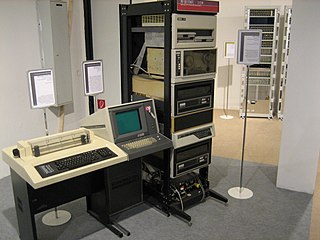
The DECwriter series was a family of computer terminals from Digital Equipment Corporation (DEC). They were typically used in a fashion similar to a teletype, with a computer output being printed to paper and the user inputting information on the keyboard. In contrast to teletypes, the DECwriters were based on dot matrix printer technology, one of the first examples of such a system to be introduced. Versions lacking a keyboard were also available for use as computer printers, which eventually became the only models as smart terminals became the main way to interact with mainframes and minicomputers in the 1980s.

ECMA-23 is a standard for a bit-paired keyboard layout adopted in 1969 and revised in 1975. As a bit-paired layout, shifted keys correspond to toggling bits in the ASCII keycode. This is most visible in the digits on the top row, where shifting 6789 give &'(), and ;+, :* and -= are paired.
